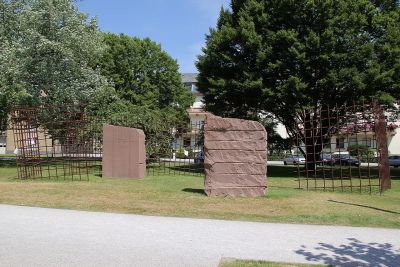Constricted remembrance: The graveyard with the memorial to the Soviet victims of the Nazis at the Mainz-Mombach Waldfriedhof
A “Russian” memorial field?
In the comprehensive document “Memorials for the Victims of National Socialism”, which was first published in 1987 by the German Federal Agency for Political Education, it is assumed that the people who were buried in the “remote grave site” were “former prisoners of a labour camp, forced labourers and prisoners of war”[6]. Polish and Czech victims are not mentioned at all however, and they are not remembered at the site: The memorial stone, which stands in front of a large lawn without gravestones and has numbered plates recessed in the bottom, which organise the anonymous resting places of thousands of people, only remembers the Soviet victims. The memorial was erected in 1950 by the Soviet military mission and written in Russian in Cyrillic letters – the German translation is on a metal plate at the foot of the memorial stone – it states:
“Eternal glory to the fighters for freedom!
3,330 Soviet citizens are buried here,
who died in Fascist captivity.
14/3/1950”
It is very similar to a smaller memorial stone from 4 March 1950 in the main cemetery in Ludwigshafen, which also remembers Soviet victims. However, in this cemetery there is also a separate Polish grave site. This notable place of remembrance in Mainz-Mombach is also remarkable in that a sign with the inscription “Russian Field of Honour” leads to this remote site in the cemetery. However, this sign also symptomatically points out the deficits in the German consciousness of remembrance in terms of heterogeneity and, in general, in terms of the presence of NS victim groups from Eastern Europe, with the Germans incorrectly equating “Soviet” and “Russian”. The Ukrainians, for example, have warned of the need to differentiate for years. If the German population knows very little about the German period of occupation and the war of extermination in Eastern Europe, in relation to the Soviet memorial, the victims of other nations, such as Belarusians or Ukrainians, who were also part of the Soviet Union and who are remembered by the memorial, remain ignored by the information on the sign. And as if this weren’t enough, other victims from Eastern Europe who are buried there, including those from Poland, are not part of this remembrance at all; they remain forgotten at this site and that is even more painful because these sites presented an opportunity to make people aware of the European dimension of the German crimes, especially in light of the scrutiny of the history in the region itself. Although politicians lay wreaths there on Remembrance Day to keep the memory of the crimes of the Nazi period alive, the wreaths are laid before a Soviet memorial near the grave site in which the dead of other nationalities have also found their resting place. Generally, the story and the fate of those who are buried there and who today are nameless remains untold.
Christof Schimsheimer, February 2022
[6] Puvogel, Ulrike; Stankowski, Martin [inter alia]: Gedenkstätten für die Opfer des Nationalsozialismus. Eine Dokumentation. Vol. 1. Second revised and extended edition. Bonn 1995, p. 676.


